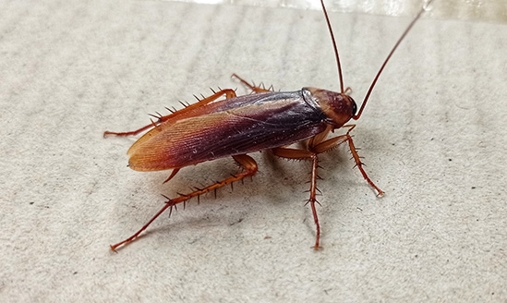Cockroaches in the Treasure Valley: From Late-Night Sightings to Lasting Control
1) Harborage Map
- Kitchens & break rooms: toe-kicks, hinge pockets, cabinet corners, under/behind refrigerators (warm motor bays), dish machines, and mop sinks.
- Bathrooms & utility rooms: pipe chases, wall voids, floor drains, and near damp trim.
- Storage & receiving: cardboard stacks, under shelving feet, and inside used appliances or equipment.
Tip: Bring a flashlight low to the floor and scan along edges—roaches track wall lines (thigmotaxis), so monitors and baits belong on those routes.
2) Quick ID Cards
- German cockroach (Blattella germanica) – Small, light-brown with two dark pronotal stripes. Most common indoors. Hides near food/water/heat; reproduces fast; responds best to gel baits + rotation and void dusts.
- Brown-banded cockroach (Supella longipalpa) – Smaller, prefers warm, dry, high sites (upper cabinets, furniture, electronics). Target higher placements; less moisture-dependent.
- American / Oriental cockroaches – Larger “waterbug” types; more tied to damp utility areas, sewers, and outdoors. They may wander in but often don’t sustain indoor populations like German roaches.
Correct ID determines where to place baits/dusts and how to follow up.
3) How They Get Established
- Introduced via cardboard deliveries, used appliances, storage totes, or shared walls/ducts.
- Hidden resources (slow drips, grease films, crumbs in cracks, warm motor bays) let a small population persist.
- Adjacent units or neighboring commercial spaces act as reservoirs and reseed activity unless plans are coordinated.
4) Health & Air Quality
Roach fragments, fecal specks, and shed skins are potent allergens linked to asthma exacerbations—especially in children. Cutting harborage, fixing moisture, HEPA-vacuuming crevices, and eliminating the infestation reduce allergen load significantly.
5) What Actually Works
Works—when done together
- Sanitation & moisture control: seal foods, fix drips/condensation, empty trash nightly, degrease edges/undersides, and HEPA-vac cracks and cabinet seams to remove allergen dust, fecal spotting, and egg cases.
- Exclusion: door sweeps; weather-strip; seal utility penetrations; caulk cabinet-to-wall gaps; inspect incoming boxes/equipment before storage.
- Targeted baits & dusts: place gel baits or stations in harborages and along foraging routes (toe-kicks, corners, hinge pockets, under/behind appliances). Apply insecticidal dusts lightly in protected voids—thin films outperform piles. Rotate compatible baits over time.
- Monitoring: place sticky monitors to map hotspots, guide re-baiting, and verify decline.
Often a waste / can backfire
- Total-release foggers and broad interior sprays: rarely reach hidden harborages, can scatter roaches deeper into walls/adjacent units, and reduce bait feeding when residues repel.
6) Service Cadence
- Visit 1 (Week 0): Confirm species; map hotspots with monitors; place gel baits and dust key voids; coach on sanitation/exclusion.
- Follow-ups:
- Biweekly by default to match label re-treat intervals and refresh baits as nymphs emerge.
- Weekly (with product rotation and selective non-repellent residuals) when activity is heavy or accounts are sensitive (multifamily corridors, food service, healthcare).
- Tapering: As monitor counts steadily drop, move to biweekly, then a maintenance cadence suited to the site.
This keeps pressure on the population without over-applying products and aligns with roach life cycles.
7) Multi-Unit & Commercial Protocol
- Coordinate access (above/below/adjacent) when monitors show migration points.
- Standardize sanitation expectations (closing tasks, degreasing schedule, trash handling).
- Receiving controls: break down cardboard outside; stage deliveries off the floor; check coolers/equipment before bringing inside.
8) What to Expect
Early wins show up as fewer trap captures and fewer late-night sightings. Kitchens and bathrooms usually quiet first; wall/utility voids can lag. In shared buildings (Boise/Nampa), we may recommend checking neighboring units to prevent re-introductions.
9) When to Call for Help
If you still see regular activity after basic cleanup and over-the-counter baiting, you likely need correct identification, targeted placements, and a follow-up cadence that matches conditions. That’s the difference between temporary relief and lasting control.
Sources
- University of California Statewide IPM Program — Cockroaches: Management Guidelines (species ID, sanitation, bait/dust strategy, monitoring):
- https://ipm.ucanr.edu/home-and-landscape/cockroaches/
- PDF Pest Notes: https://ipm.ucanr.edu/pdf/pestnotes/pncockroaches.pdf
- Pacific Northwest Pest Management Handbooks — Cockroach (regional guidance and control options):
- https://pnwhandbooks.org/insect/structural-health/household/cockroach
- Asthma and Allergy Foundation of America — Cockroach Allergy (exposure, symptoms, mitigation):
- https://aafa.org/allergies/types-of-allergies/insect-allergy/cockroach-allergy/
- U.S. EPA — Integrated Pest Management in Buildings (inspection, sanitation, exclusion, least-toxic control):
- https://www.epa.gov/safepestcontrol/integrated-pest-management-ipm-principles

